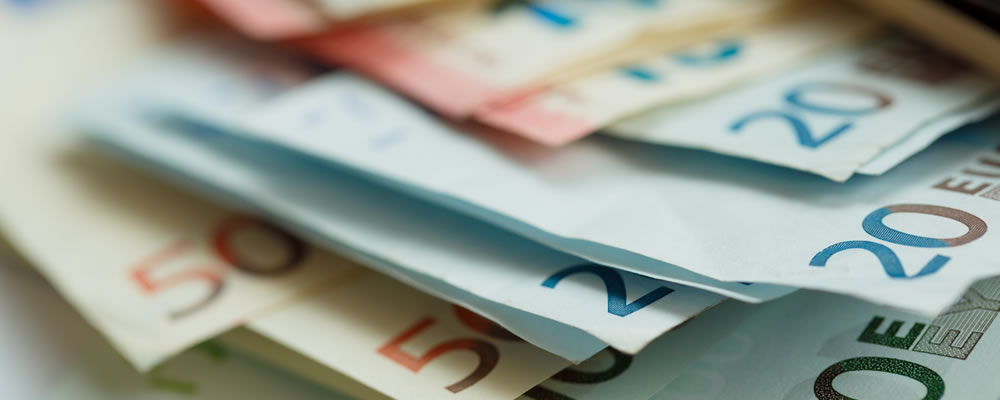Despite negative Sterling headwinds stemming from Brexit-based uncertainty the Euro to Pound exchange rate was initially unable to maintain an uptrend, faltering in response to disappointing Eurozone data. The EUR GBP exchange rate swiftly reversed losses however and remains trending above the 0.86 level with investors reluctant to buy into the Pound in the face of fresh Brexit fears and the prospect of another Bank of England (BoE) rate cut on the horizon.
- BoE suggested door open for further monetary loosening – Pound slumped as odds of 2016 interest rate cut jumped
- Lloyds business confidence measure plunged to multi-year low – EUR GBP exchange rate failed to benefit as investor sentiment remained upbeat
- Euro weighed down by narrowing of Eurozone current account – Worries over outlook of the currency union persisted
- Weaker German PPI fails to dent EUR GBP exchange rate further – Lower inflationary pressure could encourage ECB easing bias
Disappointing German Inflation Indicator Failed to Weigh on EUR GBP Exchange Rate
Even though the German Producer Price Index surprised to the downside in August this failed to particularly hamper the EUR GBP exchange rate. While prices contracted -0.1% on the month investors have been inclined to take a less bearish view of the Euro ahead of the Fed’s policy meeting on Wednesday. As markets are pricing in a minimal chance of the Federal Open Market Committee (FOMC) opting to raise interest rates at this juncture the bias for the single currency remains to the upside.
With the appeal of the Pound also turning more muted, thanks to hardening rhetoric over the UK’s exit negotiations from the EU, the EUR GBP exchange rate has been trending higher in the region of 0.8614.
(Previously updated at 11:23 on 20/09/16)
With markets antsy that the Federal Reserve could raise interest rates imminently the Euro could continue to struggle over coming days. However, if Fed policymakers ultimately opt for a less hawkish tone on monetary policy then the EUR GBP exchange rate could be prompted to trend higher later in the week.
Rising Prospect of Another BoE Rate Cut Boosted EUR GBP Exchange Rate
Despite Eurozone wage growth slowing sharply from 1.7% to 0.9% in the second quarter the appeal of the Euro (EUR) remained higher ahead of the weekend. In large part this was due to the mixed nature of the day’s US data, with a stronger inflation report contrasted by unexpected weakness in September’s University of Michigan Confidence Index. With markets revising their odds for the Federal Reserve to raise interest rates in the near future there was little reason not to favour the single currency, particularly as the Pound (GBP) remained on the back foot.
Following the Bank of England’s (BoE) indication that it remains ready to cut interest rates further if the UK economy shows greater signs of a negative post-Brexit impact, investors were inclined to sell out of Sterling. With no fresh domestic data to distract from the dovish monetary policy outlook the Euro to Pound (EUR GBP) exchange rate was able to trend strongly higher, climbing to a fresh three-week high of 0.8583.
Weakening UK Business Confidence Failed to Weigh on Pound (GBP) Demand
Some measure of confidence returned to the Pound on Monday morning as investors reacted positively to the Rightmove House Prices data for September. While price growth was a little more muted on the year this was accompanied by a strong resurgence on the month, suggesting that the domestic housing market remains in a resilient state. This helped to negate the impact of a sharp dip in the Lloyds Business in Britain report, which stated:
‘Business confidence, based on firms’ expectations for sales, orders and profits, fell to 12% from 38% in January, returning to levels seen during 2011-12, but staying well above the low reached during the global financial crisis. The survey results therefore signal the potential for a slowdown, rather than a sharp contraction, in economic growth.’
The appeal of the Euro was dented, meanwhile, by a marked narrowing of July’s current account surplus. On a seasonally adjusted basis the surplus narrowed from 29.5 billion to 21.0 billion Euros, something which would suggest that the outlook of the currency union is continuing to weaken. As a result the EUR GBP exchange rate slumped, particularly as hopes are not high for the latest Eurozone Construction Output results.
EUR GBP Exchange Rate Forecast: Disappointing German Producer Prices Could Encourage ECB Easing Bets
Tuesday’s German Producer Price Index data could prove a mixed bag for the Euro, with any suggestion of weakening inflation within the Eurozone’s powerhouse economy likely to dent sentiment. Given the worries that have been mounting over the robustness of Germany’s economic outlook a weaker showing here would not seem to bode well for the single currency, encouraging speculation that the European Central Bank (ECB) could return to an explicit easing bias in the near future.
Volatility for the Pound is expected on the back of August’s public sector borrowing data, which could offer evidence of a more negative post-referendum impact. Should borrowing re-enter deficit after the previous month’s surplus then the EUR GBP exchange rate is likely to trend higher, with higher borrowing pointing towards greater dependence on the global economy. On the other hand, if the data continues to shrug off much of the dampening effect of the Brexit vote then Sterling could regain further ground.
Current EUR, GBP Exchange Rates
At the time of writing, the Euro to Pound (EUR GBP) exchange rate was slumped in the region of 0.8537, while the Pound to Euro (GBP EUR) pairing was on an uptrend around 1.1714.



